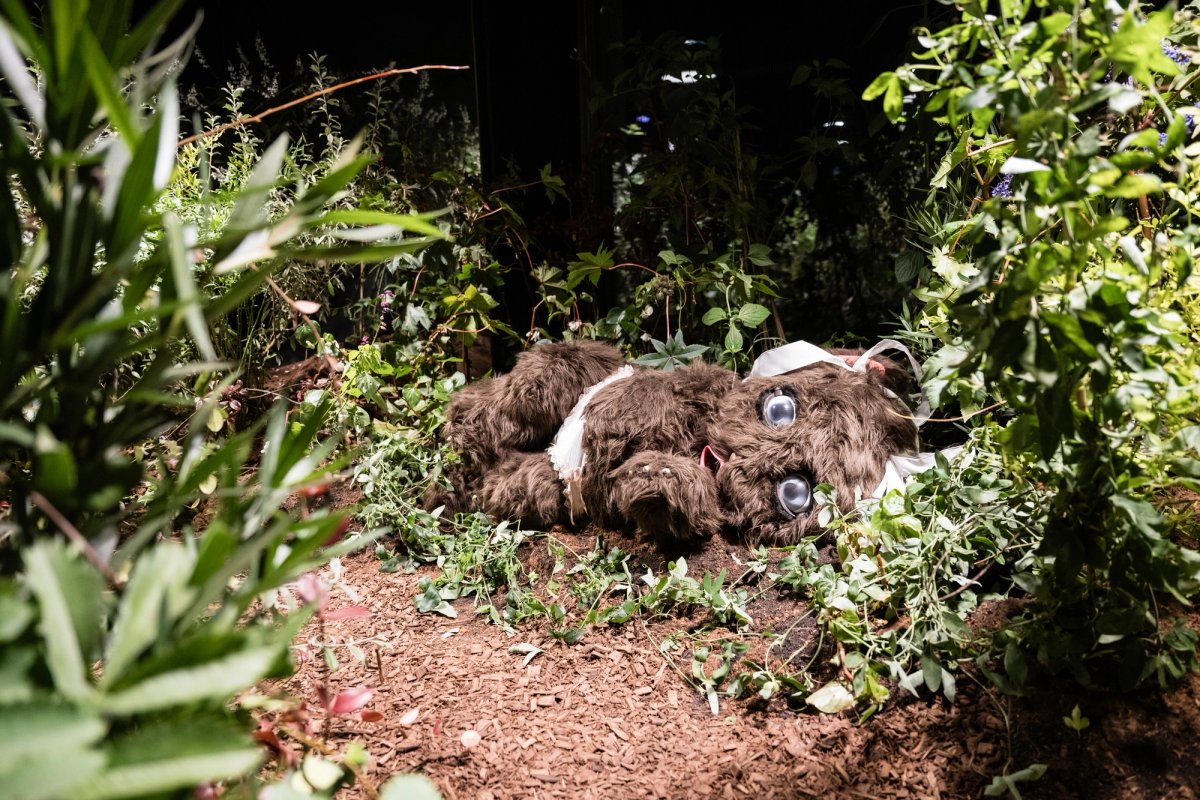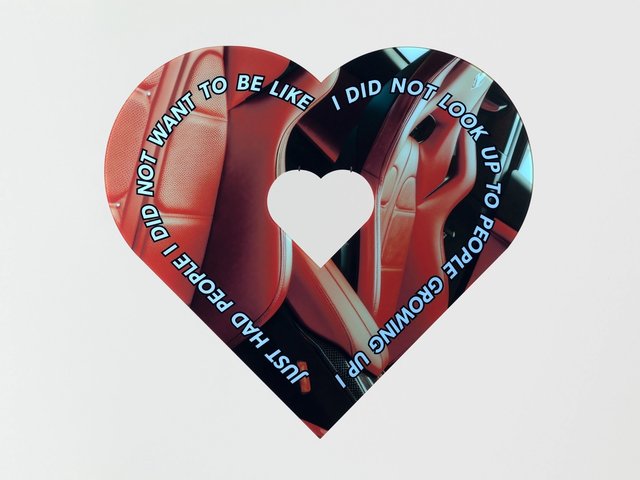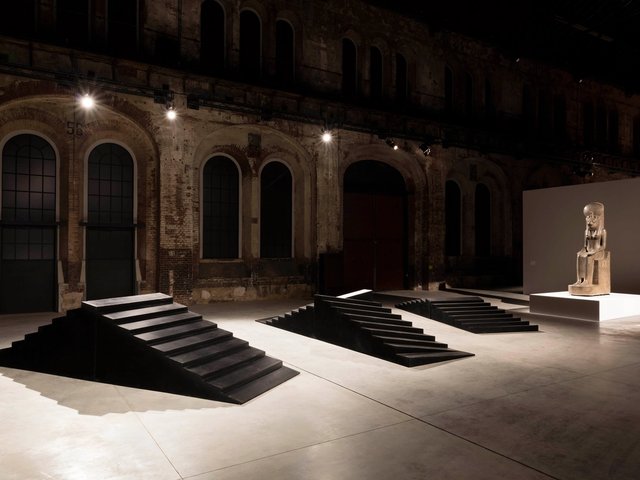Turin Art week may be focused around four days of Artissima, Italy’s leading art fair, but this year it also marked the opening of a number of significant exhibitions citywide that remain open long after the fair has ended. Once the centre of Italy’s automobile production, in recent years Turin has increasingly harnessed the legacy of its industrial past to accommodate a culture-hungry present; and many striking shows opening during Art Week were to be found in the galleries and institutions occupying the city’s former factories and warehouse buildings.
Pinacoteca Agnelli can be found within the vast former FIAT manufacturing complex at Lingotto, which dates from the 1920’s, and was renovated in the 1990’s by Renzo Piano. The crowning glory of this vast campus—which also includes a hotel and shopping mall—is Pista 500, the tilted test track running around its roof which now serves as a dramatic showcase for public art.
The two latest additions to this panoramic site are by Chalisée Naamani— winner of the 2023 Pista 500 prize in association with Artissima—and Monica Bonvicini. The first, a striking billboard, depicts the Franco-Iranian artist and her infant son in front of a voting booth, surrounded by an abundance of goods bearing multiple logos and slogans. The second, a neon installation, fills the northern end of the track with the giant illuminated exhortation: COME RUN WITH ME.
Both Bonvicini’s ambiguous reference to freedom and escape and Naamani’s mashup of political message, art history and product placement chime brilliantly with Dominque Gonzalez-Foerster’s Pistarama (2023) which was installed on the Pista’s southern curve last year. This 150 metre long panorama, made up of Torino-specific texts and images spanning from Roman engravings to contemporary graffiti, channels social struggles past and present, and taps into the city’s long history of radicalism and political dissent.
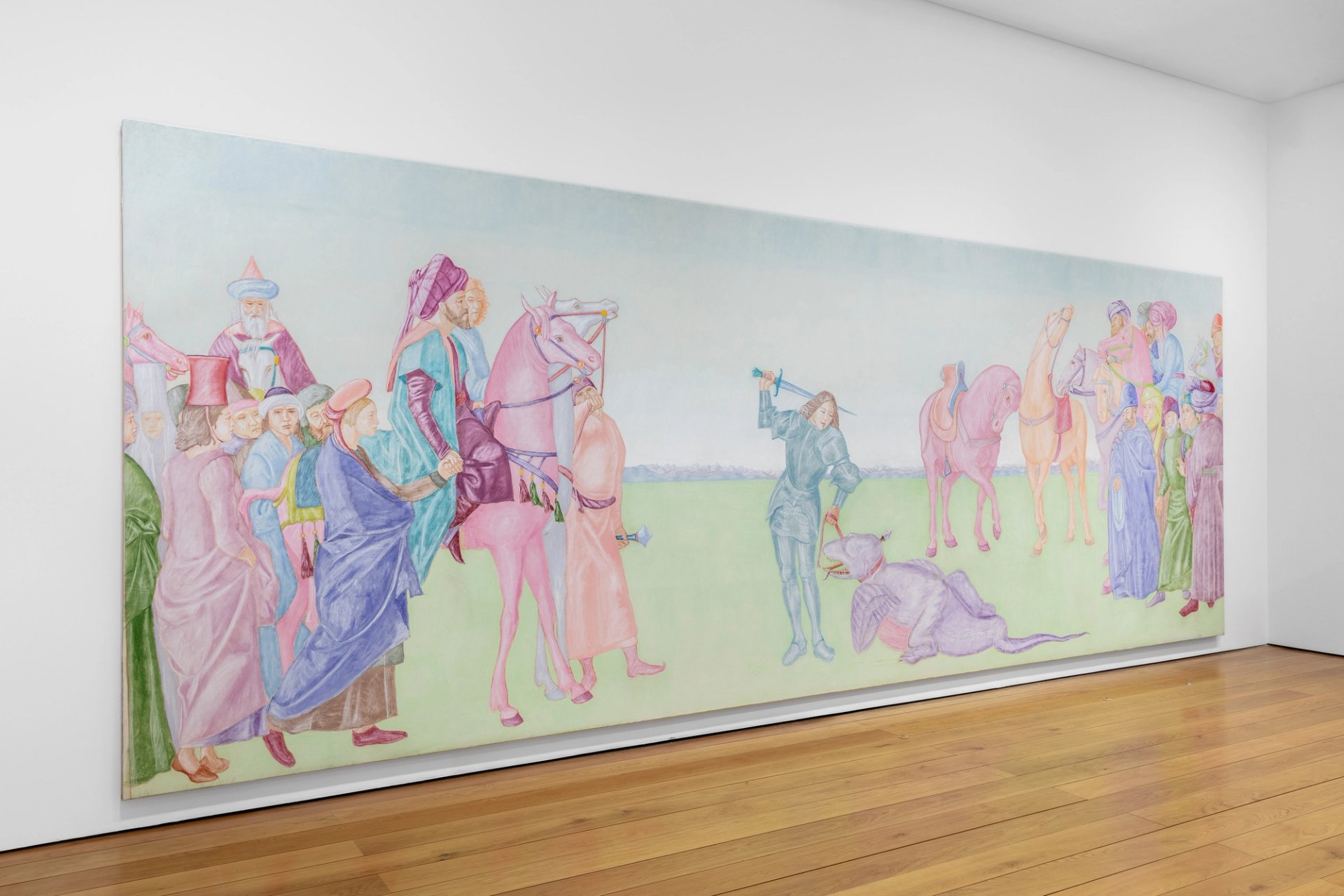
Pinacoteca Agnelli’s main galleries present the most extensive survey to date of the Italian artist Salvatore Mangion
Image Courtesy Pinacoteca Agnelli, Torino. Photograph: Sebastiano Pellion di Persano
Meanwhile Pinacoteca Agnelli’s main galleries contain the most extensive survey to date of the Italian artist Salvo—aka Salvatore Mangione—who was born in Sicily but relocated to Turin as a child, where lived until his death in 2015. Salvo; Arrivare in tempo [Arriving on time] challenges the commonly held view that in the early 70’s this quixotic provocateur abruptly changed course from making conceptual art to embrace a more conservative painterly figuration. Innstead, it places Salvo’s crisply executed, trippily coloured canvases firmly within the context of his earlier arte povera-influenced investigations. Organised thematically and grouped according to oft-repeated motifs—including factories, streetlamps, moonscapes and his especially incongruous pastel-hued renditions of classic St Georges slaying their dragons—Salvo’s serial repetitions and interrogations of art history are rebooted in a way that seems contemporary.
Fondazione Merz
The decommissioned 1930s power station for the Lancia factory is another relic from Turin’s automobile producing heyday, which since 2005 has housed the Fondazione Merz. Here a show of key works by Mario Merz has been gathered both from the Fondazione’s holdings and from rare private loans. The exhibition is a prelude to the centenary celebrations of Merz’s birth, which will take place on 1 January 2025.
Objects include drawings, canvases, sculptural objects and three classic igloos made, respectively, from stone, bread and paraffin-steeped gold leaves. Also making its European debut is Merz’s stunning 1985 Quattro tavoli in forma di foglie di magnolia [Four tables in the form of Magnolia leaves]. This sixteen-part work, with various objects and substances embedded in its wax surfaces, was specifically created for a show in Sperone Westwater and Leo Castelli galleries in New York. However, it looks very much at home snaking through this double height substation that is now devoted to the power of art until 2 February 2025.
OGR Torino
In OGR Torino, an immense site for art and performance built in the late 19th century for the maintenance of railway vehicles, the main vaulted chamber will be occupied until 2 February 2025 by Cyprien Gaillard’s most recent 3D video work, Retinal Rivalry (2024) . This exploration into ways of seeing employs the latest in stereoscopic filming and projection technologies to probe and view various German locations in unexpected and uncanny ways. The work, which is accompanied by an evocative eclectic soundtrack also composed by the artist, premiered in Fondation Beyeler earlier this year, but is rendered especially disconcerting due to the contrast in scale between Gaillard’s often intensely close-up perspectives of pavements, parks and buildings—which in their 3D incarnations loom like spectres—and OGR’s epically expansive interior.
Fondazione Giorgio Griffa
It’s common practice in cities worldwide for artists to use decommissioned industrial and manufacturing buildings as studio space and Turin is no exception. Last year the Fondazione Giorgio Griffa was established in part of the former Michelin tyre plant near Turin’s historical centre, where for many years the 88-year-old artist has his studio. Now Griffa’s Fondazione has inaugurated a new exhibition space on the building’s ground floor with INSIDE, a collegial group show (until 12 December) that links and celebrates the work of all seven artists who are long term occupants of the building.
Griffa is showing a vibrant painting made earlier this year, alongside works by his compadres. These include an exquisite 1974 ink drawing on parchment paper by Arte Povera veteran Gilberto Zorio, a lead wall piece by fellow octogenarian Marco Gastini, as well as one of Luigi Mainolfi’s recent terracotta sculptures and a complex multilayered 2024 print on satin by Elisa Sighicelli.
Galeria Civica d’Arte Moderna e Contemporareo di Torino
Turin was the first Italian city to build up a civic collection of modern art and since 1959 this has been housed in the Galeria Civica d’Arte Moderna e Contemporareo di Torino (GAM), which has recently re-opened after a comprehensive refurbishment of its classic purpose built mid-century modernist building. Under the leadership of newly appointed director Chiara Bertola, GAM’s collections have also been radically reorganised, and the new-look GAM has also unveiled several major shows. These include American abstract painter Mary Heilmann (until 16 March); the French Impressionist Berthe Morisot, with additional provocative interventions by Italian ‘intruder’ artist Stefano Arienti, (until 9 March); and a solo exhibition of the chromatic explorations of the Italian artist Maria Morganti (until 16 March).
Castello di Rivoli
Castello di Rivoli, the former residence of the House of Savoy and a museum of contemporary art since 1984, is another venerable Turin institution with a new director at the helm. Francesco Manacorda, who took over from Carolyn Christov-Bakargiev in January this year, is the co-curator of Mutual Aid: Art in Collaboration with Nature (until 23 March 2023), alongside Marianna Vecellio. The exhibition builds on the Castello’s arte-povera heritage and its dedication to process and transience by focusing on works initiated by artists but completed by myriad natural forces.
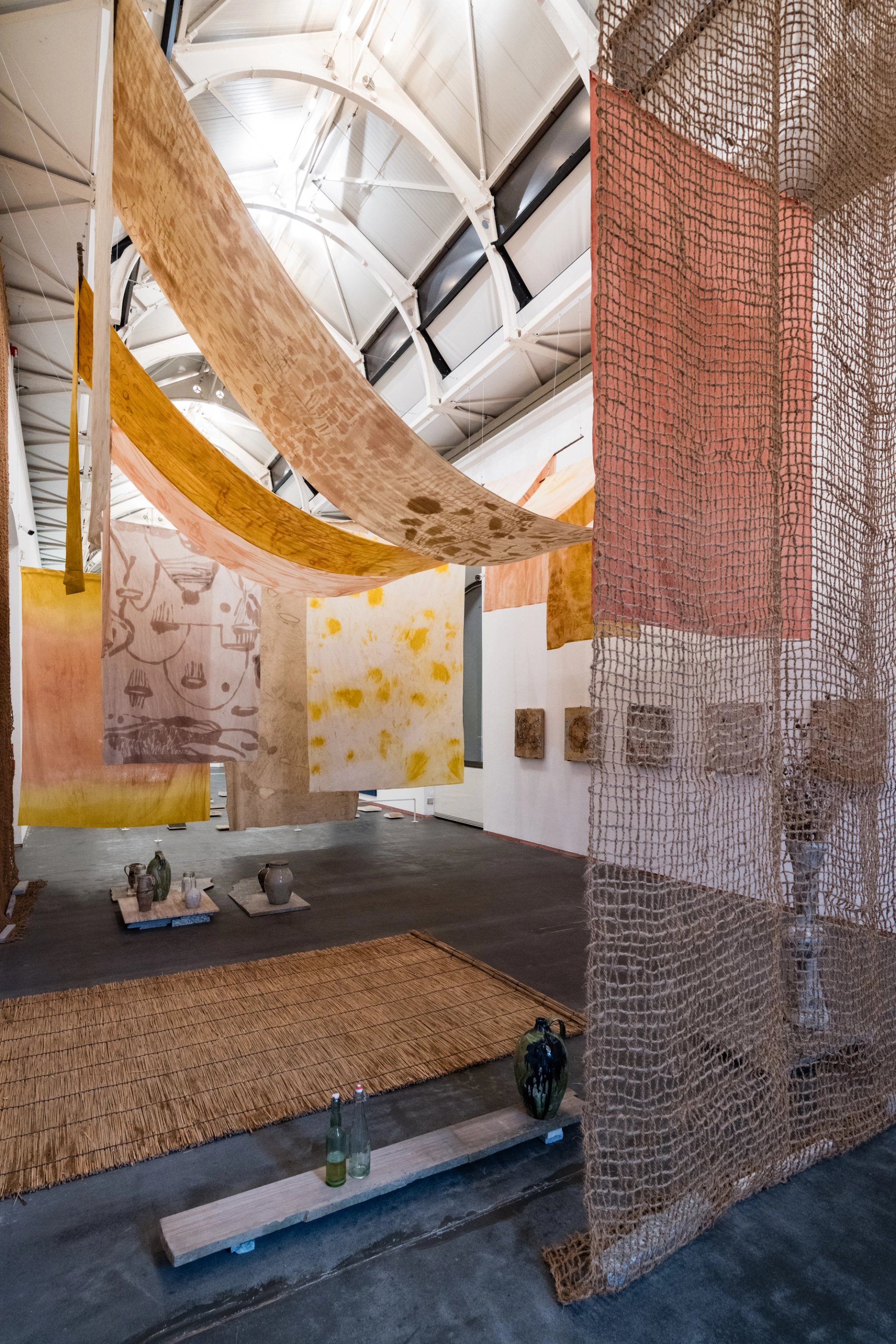
Giuseppe Penone’s symbiotic interaction with Alpine ash trees is just one element of this show that focuses on the power natural forces
Courtesy Castello di Rivoli – Museo d’Arte Contemporanea, Rivoli-Torino
Starting with Giuseppe Penone’s symbiotic interaction with Alpine ash trees in the 1960’s and Vivien Suitor’s paintings that harness the forces of the Guatemalan rainforest, this exploration of interspecies interactions extends through Michel Blazy’s action paintings made by snail trails. It then moves on to Tomas Saraceno’s spiderweb sculptures and Precious Okoyomon’s sweltering garden of toxic plants inhabited by flapping butterflies and an intermittently screaming animatronic bear.
Fondazione Sandretto Re Rebaudengo
Patrizia Sandretto Re Rebaudego, Turin’s grandest of art patrons, has had an association with the Dutch artist Mark Manders that stretches back some three decades. The length and strength of this relationship is reflected in the exceptional show that has just opened at Fondazione Sandretto Re Rebaudengo, the first for Manders in an Italian institution.
Although there are works dating from the early 1990’s, right up to pieces completed only a few weeks ago, Mark Manders: Silent Studio (until 16 March 2025) is not so much a survey as a series of all-encompassing environments. These play with and off ideas around fact, fiction, art history and self portraiture, and permeate every part of the Fondazione—even its toilet.
Plastic-lined chambers that contain monumental anonymous clay heads might suggest a rough in-progress studio space, but the mind boggles in the knowledge that these crumbling clay colossi are in fact made from meticulously cast and painted bronze. The same can be said of the rough bundles of newspapers that feature in many works, which are painstaking compilations of all the English words in existence, collected and printed by the artist. In this magical, memorable show all is mysterious and open to interpretation; and for me it was a one of the highlights amongst the many excellent exhibitions in Turin’s institutions and foundations that confirm the city as Italy’s pre-eminent centre for contemporary art.


